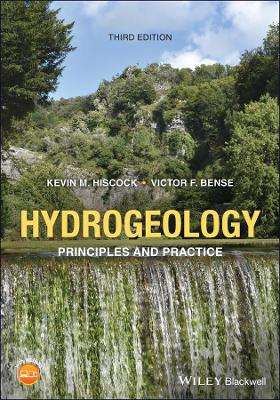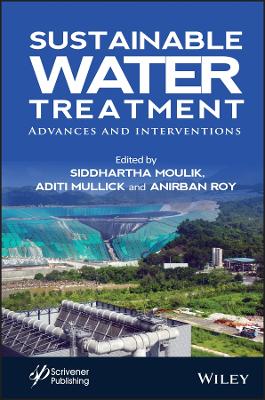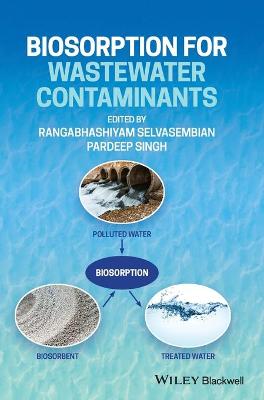Hydrogeology
 -15%
portes grátis
-15%
portes grátis
Hydrogeology
Principles and Practice
Bense, Victor F.; Hiscock, Kevin M.
John Wiley and Sons Ltd
12/2021
768
Mole
Inglês
9781119569534
15 a 20 dias
1642
Descrição não disponível.
List of colour plates xi
List of boxes xiv
Preface to the third edition xvi
Preface to the second edition xvi
Preface to the first edition xvii
Acknowledgements xviii
Symbols and abbreviations xix
About the companion website xxiii
1. Introduction 1
1.1 Scope of this book
1.2 What is hydrogeology?
1.3 Early examples of groundwater exploitation
1.4 History of hydrogeology
1.5 The water cycle
1.5.1 Groundwater occurrence in the upper continental crust
1.5.2 Groundwater-related tipping points
1.5.3 Groundwater discharge to the oceans
1.5.4 Global groundwater material and elemental fluxes
1.5.5 Human influence on the water cycle
1.6 Global groundwater resources
1.6.1 Global groundwater abstraction
1.6.2 Global groundwater depletion and sea level rise
1.7 Groundwater resources in developed countries
1.7.1 Groundwater abstraction in the United Kingdom
1.7.1.1?Management and protection of groundwater resources in the United Kingdom
1.7.2 Groundwater abstraction in Europe
1.7.2.1?European Union Water Framework Directive
1.7.3 Groundwater abstraction in North America
1.7.3.1?Management and protection of groundwater resources in the United States
1.7.4 Groundwater abstraction in China
1.8 Groundwater resources in developing countries
Further reading
References
2. Physical hydrogeology
2.1 Introduction
2.2 Porosity
2.3 Hydraulic conductivity
2.4 Isotropy and homogeneity
2.5 Aquifers, aquitards and aquicludes
2.6 Darcy's Law
2.6.1 Hydraulic properties of fractured rocks
2.6.2 Karst aquifer properties
2.6.3 Sinkholes and land subsidence
2.7 Groundwater potential and hydraulic head
2.8 Interpretation of hydraulic head and groundwater conditions
2.8.1 Groundwater flow direction
2.8.2 Water table and potentiometric surface maps
2.8.3 Types of groundwater conditions
2.9 Transmissivity and storativity of confined aquifers
2.9.1 Release of water from confined aquifers
2.10 Transmissivity and specific yield of unconfined aquifers
2.11 Equations of groundwater flow
2.11.1 Steady-state saturated flow
2.11.2 Transient saturated flow
2.11.3 Transient unsaturated flow
2.12 Analytical solution of one-dimensional groundwater flow problems
2.13 Groundwater flow patterns
2.14 Classification of springs and intermittent streams
2.15 Transboundary aquifer systems
2.16 Submarine groundwater discharge
2.17 Groundwater resources of the world
2.18 Hydrogeological environments of the United Kingdom
2.18.1 Sedimentary rocks
2.18.2 Metamorphic rocks
2.18.3 Igneous rocks
Further reading
References
3. Groundwater and geological processes
3.1 Introduction
3.2 Geological processes driving fluid flow
3.3 Topography-driven flow in the context of geological processes
3.4 Compaction-driven fluid flow
3.5 Variable-density driven fluid flow
3.5.1 Salinity gradients leading to variable-density flow
3.5.2 Hydrothermal systems driven by variable-density flow
3.6 Regional groundwater flow systems driven predominantly by variable-density flow
3.6.1 Fluctuating sea-level and its impact on the distribution of groundwater salinity in coastal areas
3.6.2 Brines in continental aquifers
3.7 Regional groundwater flow systems driven predominantly by shifting topography and stress changes
3.7.1 Mountain building and erosion
3.7.2 Impact of glaciations on regional hydrogeology
3.8 Coupling and relative importance of processes driving fluid flow
Further reading
References
4. Chemical hydrogeology
4.1 Introduction
4.2 Properties of water
4.3 Chemical composition of groundwater
4.4 Sequence of hydrochemical evolution of groundwater
4.5 Groundwater sampling and graphical presentation of hydrochemical data
4.6 Concept of chemical equilibrium
4.6.1 Kinetic approach to chemical equilibrium
4.6.2 Energetic approach to chemical equilibrium
4.7 Carbonate chemistry of groundwater
4.8 Adsorption and ion exchange
4.9 Redox chemistry, 172
4.10 Groundwater in crystalline rocks
4.11 Geochemical modelling
Further reading
References
5. Environmental isotope hydrogeology
5.1 Introduction
5.2 Stable isotope chemistry and nomenclature
5.3 Stable isotopes of water
5.4 Stable isotopes of nitrogen and sulfur
5.4.1 Nitrogen stable isotopes
5.4.2 Sulphur stable isotopes
5.5 Age dating of groundwater
5.5.1 Law of radioactive decay
5.5.2 14C dating
5.5.3 36Cl dating
5.5.4 Tritium dating
5.5.5 3H/3He dating
5.6 Noble gases
Further reading
References
6. Groundwater and catchment processes
6.1 Introduction
6.2 Water balance equation
6.3 Precipitation and evapotranspiration
6.3.1 Precipitation measurement
6.3.2 Evapotranspiration measurement and estimation
6.4 Soil water and infiltration
6.4.1 Soil moisture content and soil water potential
6.4.2 Calculation of drainage and evaporation losses
6.4.3 Infiltration theory and measurement
6.5 Recharge estimation
6.5.1 Borehole hydrograph method
6.5.2 Soil moisture budget method
6.5.3 Chloride budget method
6.5.4 Temperature profile methods
6.6 Stream gauging techniques
6.6.1 Velocity area methods
6.6.1.1 Surface floats
6.6.1.2 Current metering
6.6.1.3 Acoustic Doppler current profiler
6.6.2 Dilution gauging
6.6.3 Ultrasonic, electromagnetic and integrating float methods
6.6.4 Slope-area method
6.6.5 Weirs and flumes
6.7 Hydrograph analysis
6.7.1 Quickflow and baseflow separation
6.7.2 Unit hydrograph theory
6.8 Surface water - groundwater interaction
6.8.1 Temperature-based methods of detection
6.8.2 Simulating river flow depletion
6.8.2.1 Analytical solutions
6.8.2.2 Catchment resource modelling
6.8.2.3 Global-scale surface water-groundwater modelling
Further reading
References
7. Groundwater investigation techniques
7.1 Introduction
7.2 Measurement and interpretation of groundwater level data
7.2.1 Water level measurement
7.2.2 Well and borehole design and construction methods
7.2.3 Borehole hydrographs and barometric efficiency
7.2.3.1?Groundwater level fluctuations in the Bengal Basin Aquifer
7.2.4 Construction of groundwater level contour maps
7.3 Field estimation of aquifer properties
7.3.1 Piezometer tests
7.3.2 Pumping tests
7.3.2.1 Thiem equilibrium method
7.3.2.2 Theis non-equilibrium method
7.3.2.3 Cooper-Jacob straight-line method
7.3.2.4 Recovery test method
7.3.2.5 Principle of superposition of drawdown
7.3.2.6 Leaky, unconfined and bounded aquifer systems
7.3.3 Tracer tests
7.3.4 Downhole geophysical techniques
7.3.4.1 Examples of downhole geophysical logging
7.3.5 Surface geophysical techniques
7.3.5.1 Seismic refraction survey method
7.3.5.2 Electrical resistivity survey method
7.3.5.3 Electromagnetic survey method
7.3.5.4 Gravity survey method
7.3.5.5 Examples of surface geophysical surveying
7.4 Remote sensing methods
7.5 Groundwater modelling
Further reading
References
8. Groundwater quality and contaminant hydrogeology
8.1 Introduction
8.2 Water quality standards
8.2.1 Water hardness
8.2.2 Irrigation water quality
8.3 Transport of contaminants in groundwater
8.3.1 Transport of non-reactive dissolved contaminants
8.3.1.1 One-dimensional solute transport equation
8.3.2 Transport of reactive dissolved contaminants
8.3.3 Transport of non-aqueous phase liquids
8.3.3.1 Hydrophobic sorption of non-polar organic compounds
8.3.4 Effects of density and heterogeneity
8.4 Sources of groundwater contamination
8.4.1 Urban and industrial contaminants
8.4.2 Municipal landfill wastes
8.4.3 Faecal, domestic and cemetery wastes
8.4.4 Microplastic contamination
8.4.5 Agricultural contaminants
8.4.6 Saline water intrusion in coastal aquifers
8.4.7 Saline water intrusion on small oceanic islands
Further reading
References
9. Groundwater pollution remediation and protection
9.1 Introduction
9.2 Groundwater pollution remediation techniques
9.2.1 Pump-and-treat
9.2.2 Permeable reactive barriers
9.2.3 Monitored natural attenuation
9.3 Groundwater pollution protection strategies in developed countries
9.3.1 Groundwater vulnerability mapping and aquifer resource protection
9.3.2 Source protection zones
9.3.3 Risk assessment methods
9.3.4 Groundwater vulnerability assessment and mapping for the protection of carbonate (karstic) aquifers
9.3.5 Spatial planning and groundwater protection
9.4 Groundwater protection strategies in developing countries
Further reading
References
10. Groundwater resources, governance and management
10.1 Introduction
10.2 Groundwater resources schemes
10.2.1 Large-scale groundwater development schemes
10.2.2 Regional-scale groundwater development schemes
10.2.3 Managed aquifer recharge
10.2.3.1 Artificial storage and recovery schemes
10.2.3.2 Riverbank filtration schemes
10.2.4 Horizontal well schemes
10.3 Wetland hydrogeology
10.3.1 Impacts of groundwater exploitation on wetlands
10.3.2 Hydrogeology of dune slacks
10.4 Climate change and groundwater resources
10.4.1 Groundwater response time to climate change
10.4.2 Groundwater pumping and greenhouse gas emissions
10.4.3 Impact of climate change on cold-region hydrogeology
10.4.4 Adaptation to climate change
10.5 Groundwater and energy resources
10.5.1 Geothermal energy
10.5.2 Groundwater source heat pumps
10.5.3 Groundwater and shale gas exploration
10.6 Future challenges for groundwater governance and management
Further reading
References
Appendices
1. Conversion factors
2. Properties of water in the range 0-100 degreesC
3. The geological timescale
4. Symbols, atomic numbers and atomic weights
5. Composition of seawater and rainwater
References
6. Values of W(u) for various values of u
7. Values of q/Q and v/Qt corresponding to selected values of t/F for use in computing the rate and volume of stream depletion by wells and boreholes
8. Complementary error function
9. Drinking water quality standards and Lists I and II Substances
10. Review questions and exercises
References
Index
List of boxes xiv
Preface to the third edition xvi
Preface to the second edition xvi
Preface to the first edition xvii
Acknowledgements xviii
Symbols and abbreviations xix
About the companion website xxiii
1. Introduction 1
1.1 Scope of this book
1.2 What is hydrogeology?
1.3 Early examples of groundwater exploitation
1.4 History of hydrogeology
1.5 The water cycle
1.5.1 Groundwater occurrence in the upper continental crust
1.5.2 Groundwater-related tipping points
1.5.3 Groundwater discharge to the oceans
1.5.4 Global groundwater material and elemental fluxes
1.5.5 Human influence on the water cycle
1.6 Global groundwater resources
1.6.1 Global groundwater abstraction
1.6.2 Global groundwater depletion and sea level rise
1.7 Groundwater resources in developed countries
1.7.1 Groundwater abstraction in the United Kingdom
1.7.1.1?Management and protection of groundwater resources in the United Kingdom
1.7.2 Groundwater abstraction in Europe
1.7.2.1?European Union Water Framework Directive
1.7.3 Groundwater abstraction in North America
1.7.3.1?Management and protection of groundwater resources in the United States
1.7.4 Groundwater abstraction in China
1.8 Groundwater resources in developing countries
Further reading
References
2. Physical hydrogeology
2.1 Introduction
2.2 Porosity
2.3 Hydraulic conductivity
2.4 Isotropy and homogeneity
2.5 Aquifers, aquitards and aquicludes
2.6 Darcy's Law
2.6.1 Hydraulic properties of fractured rocks
2.6.2 Karst aquifer properties
2.6.3 Sinkholes and land subsidence
2.7 Groundwater potential and hydraulic head
2.8 Interpretation of hydraulic head and groundwater conditions
2.8.1 Groundwater flow direction
2.8.2 Water table and potentiometric surface maps
2.8.3 Types of groundwater conditions
2.9 Transmissivity and storativity of confined aquifers
2.9.1 Release of water from confined aquifers
2.10 Transmissivity and specific yield of unconfined aquifers
2.11 Equations of groundwater flow
2.11.1 Steady-state saturated flow
2.11.2 Transient saturated flow
2.11.3 Transient unsaturated flow
2.12 Analytical solution of one-dimensional groundwater flow problems
2.13 Groundwater flow patterns
2.14 Classification of springs and intermittent streams
2.15 Transboundary aquifer systems
2.16 Submarine groundwater discharge
2.17 Groundwater resources of the world
2.18 Hydrogeological environments of the United Kingdom
2.18.1 Sedimentary rocks
2.18.2 Metamorphic rocks
2.18.3 Igneous rocks
Further reading
References
3. Groundwater and geological processes
3.1 Introduction
3.2 Geological processes driving fluid flow
3.3 Topography-driven flow in the context of geological processes
3.4 Compaction-driven fluid flow
3.5 Variable-density driven fluid flow
3.5.1 Salinity gradients leading to variable-density flow
3.5.2 Hydrothermal systems driven by variable-density flow
3.6 Regional groundwater flow systems driven predominantly by variable-density flow
3.6.1 Fluctuating sea-level and its impact on the distribution of groundwater salinity in coastal areas
3.6.2 Brines in continental aquifers
3.7 Regional groundwater flow systems driven predominantly by shifting topography and stress changes
3.7.1 Mountain building and erosion
3.7.2 Impact of glaciations on regional hydrogeology
3.8 Coupling and relative importance of processes driving fluid flow
Further reading
References
4. Chemical hydrogeology
4.1 Introduction
4.2 Properties of water
4.3 Chemical composition of groundwater
4.4 Sequence of hydrochemical evolution of groundwater
4.5 Groundwater sampling and graphical presentation of hydrochemical data
4.6 Concept of chemical equilibrium
4.6.1 Kinetic approach to chemical equilibrium
4.6.2 Energetic approach to chemical equilibrium
4.7 Carbonate chemistry of groundwater
4.8 Adsorption and ion exchange
4.9 Redox chemistry, 172
4.10 Groundwater in crystalline rocks
4.11 Geochemical modelling
Further reading
References
5. Environmental isotope hydrogeology
5.1 Introduction
5.2 Stable isotope chemistry and nomenclature
5.3 Stable isotopes of water
5.4 Stable isotopes of nitrogen and sulfur
5.4.1 Nitrogen stable isotopes
5.4.2 Sulphur stable isotopes
5.5 Age dating of groundwater
5.5.1 Law of radioactive decay
5.5.2 14C dating
5.5.3 36Cl dating
5.5.4 Tritium dating
5.5.5 3H/3He dating
5.6 Noble gases
Further reading
References
6. Groundwater and catchment processes
6.1 Introduction
6.2 Water balance equation
6.3 Precipitation and evapotranspiration
6.3.1 Precipitation measurement
6.3.2 Evapotranspiration measurement and estimation
6.4 Soil water and infiltration
6.4.1 Soil moisture content and soil water potential
6.4.2 Calculation of drainage and evaporation losses
6.4.3 Infiltration theory and measurement
6.5 Recharge estimation
6.5.1 Borehole hydrograph method
6.5.2 Soil moisture budget method
6.5.3 Chloride budget method
6.5.4 Temperature profile methods
6.6 Stream gauging techniques
6.6.1 Velocity area methods
6.6.1.1 Surface floats
6.6.1.2 Current metering
6.6.1.3 Acoustic Doppler current profiler
6.6.2 Dilution gauging
6.6.3 Ultrasonic, electromagnetic and integrating float methods
6.6.4 Slope-area method
6.6.5 Weirs and flumes
6.7 Hydrograph analysis
6.7.1 Quickflow and baseflow separation
6.7.2 Unit hydrograph theory
6.8 Surface water - groundwater interaction
6.8.1 Temperature-based methods of detection
6.8.2 Simulating river flow depletion
6.8.2.1 Analytical solutions
6.8.2.2 Catchment resource modelling
6.8.2.3 Global-scale surface water-groundwater modelling
Further reading
References
7. Groundwater investigation techniques
7.1 Introduction
7.2 Measurement and interpretation of groundwater level data
7.2.1 Water level measurement
7.2.2 Well and borehole design and construction methods
7.2.3 Borehole hydrographs and barometric efficiency
7.2.3.1?Groundwater level fluctuations in the Bengal Basin Aquifer
7.2.4 Construction of groundwater level contour maps
7.3 Field estimation of aquifer properties
7.3.1 Piezometer tests
7.3.2 Pumping tests
7.3.2.1 Thiem equilibrium method
7.3.2.2 Theis non-equilibrium method
7.3.2.3 Cooper-Jacob straight-line method
7.3.2.4 Recovery test method
7.3.2.5 Principle of superposition of drawdown
7.3.2.6 Leaky, unconfined and bounded aquifer systems
7.3.3 Tracer tests
7.3.4 Downhole geophysical techniques
7.3.4.1 Examples of downhole geophysical logging
7.3.5 Surface geophysical techniques
7.3.5.1 Seismic refraction survey method
7.3.5.2 Electrical resistivity survey method
7.3.5.3 Electromagnetic survey method
7.3.5.4 Gravity survey method
7.3.5.5 Examples of surface geophysical surveying
7.4 Remote sensing methods
7.5 Groundwater modelling
Further reading
References
8. Groundwater quality and contaminant hydrogeology
8.1 Introduction
8.2 Water quality standards
8.2.1 Water hardness
8.2.2 Irrigation water quality
8.3 Transport of contaminants in groundwater
8.3.1 Transport of non-reactive dissolved contaminants
8.3.1.1 One-dimensional solute transport equation
8.3.2 Transport of reactive dissolved contaminants
8.3.3 Transport of non-aqueous phase liquids
8.3.3.1 Hydrophobic sorption of non-polar organic compounds
8.3.4 Effects of density and heterogeneity
8.4 Sources of groundwater contamination
8.4.1 Urban and industrial contaminants
8.4.2 Municipal landfill wastes
8.4.3 Faecal, domestic and cemetery wastes
8.4.4 Microplastic contamination
8.4.5 Agricultural contaminants
8.4.6 Saline water intrusion in coastal aquifers
8.4.7 Saline water intrusion on small oceanic islands
Further reading
References
9. Groundwater pollution remediation and protection
9.1 Introduction
9.2 Groundwater pollution remediation techniques
9.2.1 Pump-and-treat
9.2.2 Permeable reactive barriers
9.2.3 Monitored natural attenuation
9.3 Groundwater pollution protection strategies in developed countries
9.3.1 Groundwater vulnerability mapping and aquifer resource protection
9.3.2 Source protection zones
9.3.3 Risk assessment methods
9.3.4 Groundwater vulnerability assessment and mapping for the protection of carbonate (karstic) aquifers
9.3.5 Spatial planning and groundwater protection
9.4 Groundwater protection strategies in developing countries
Further reading
References
10. Groundwater resources, governance and management
10.1 Introduction
10.2 Groundwater resources schemes
10.2.1 Large-scale groundwater development schemes
10.2.2 Regional-scale groundwater development schemes
10.2.3 Managed aquifer recharge
10.2.3.1 Artificial storage and recovery schemes
10.2.3.2 Riverbank filtration schemes
10.2.4 Horizontal well schemes
10.3 Wetland hydrogeology
10.3.1 Impacts of groundwater exploitation on wetlands
10.3.2 Hydrogeology of dune slacks
10.4 Climate change and groundwater resources
10.4.1 Groundwater response time to climate change
10.4.2 Groundwater pumping and greenhouse gas emissions
10.4.3 Impact of climate change on cold-region hydrogeology
10.4.4 Adaptation to climate change
10.5 Groundwater and energy resources
10.5.1 Geothermal energy
10.5.2 Groundwater source heat pumps
10.5.3 Groundwater and shale gas exploration
10.6 Future challenges for groundwater governance and management
Further reading
References
Appendices
1. Conversion factors
2. Properties of water in the range 0-100 degreesC
3. The geological timescale
4. Symbols, atomic numbers and atomic weights
5. Composition of seawater and rainwater
References
6. Values of W(u) for various values of u
7. Values of q/Q and v/Qt corresponding to selected values of t/F for use in computing the rate and volume of stream depletion by wells and boreholes
8. Complementary error function
9. Drinking water quality standards and Lists I and II Substances
10. Review questions and exercises
References
Index
Este título pertence ao(s) assunto(s) indicados(s). Para ver outros títulos clique no assunto desejado.
List of colour plates xi
List of boxes xiv
Preface to the third edition xvi
Preface to the second edition xvi
Preface to the first edition xvii
Acknowledgements xviii
Symbols and abbreviations xix
About the companion website xxiii
1. Introduction 1
1.1 Scope of this book
1.2 What is hydrogeology?
1.3 Early examples of groundwater exploitation
1.4 History of hydrogeology
1.5 The water cycle
1.5.1 Groundwater occurrence in the upper continental crust
1.5.2 Groundwater-related tipping points
1.5.3 Groundwater discharge to the oceans
1.5.4 Global groundwater material and elemental fluxes
1.5.5 Human influence on the water cycle
1.6 Global groundwater resources
1.6.1 Global groundwater abstraction
1.6.2 Global groundwater depletion and sea level rise
1.7 Groundwater resources in developed countries
1.7.1 Groundwater abstraction in the United Kingdom
1.7.1.1?Management and protection of groundwater resources in the United Kingdom
1.7.2 Groundwater abstraction in Europe
1.7.2.1?European Union Water Framework Directive
1.7.3 Groundwater abstraction in North America
1.7.3.1?Management and protection of groundwater resources in the United States
1.7.4 Groundwater abstraction in China
1.8 Groundwater resources in developing countries
Further reading
References
2. Physical hydrogeology
2.1 Introduction
2.2 Porosity
2.3 Hydraulic conductivity
2.4 Isotropy and homogeneity
2.5 Aquifers, aquitards and aquicludes
2.6 Darcy's Law
2.6.1 Hydraulic properties of fractured rocks
2.6.2 Karst aquifer properties
2.6.3 Sinkholes and land subsidence
2.7 Groundwater potential and hydraulic head
2.8 Interpretation of hydraulic head and groundwater conditions
2.8.1 Groundwater flow direction
2.8.2 Water table and potentiometric surface maps
2.8.3 Types of groundwater conditions
2.9 Transmissivity and storativity of confined aquifers
2.9.1 Release of water from confined aquifers
2.10 Transmissivity and specific yield of unconfined aquifers
2.11 Equations of groundwater flow
2.11.1 Steady-state saturated flow
2.11.2 Transient saturated flow
2.11.3 Transient unsaturated flow
2.12 Analytical solution of one-dimensional groundwater flow problems
2.13 Groundwater flow patterns
2.14 Classification of springs and intermittent streams
2.15 Transboundary aquifer systems
2.16 Submarine groundwater discharge
2.17 Groundwater resources of the world
2.18 Hydrogeological environments of the United Kingdom
2.18.1 Sedimentary rocks
2.18.2 Metamorphic rocks
2.18.3 Igneous rocks
Further reading
References
3. Groundwater and geological processes
3.1 Introduction
3.2 Geological processes driving fluid flow
3.3 Topography-driven flow in the context of geological processes
3.4 Compaction-driven fluid flow
3.5 Variable-density driven fluid flow
3.5.1 Salinity gradients leading to variable-density flow
3.5.2 Hydrothermal systems driven by variable-density flow
3.6 Regional groundwater flow systems driven predominantly by variable-density flow
3.6.1 Fluctuating sea-level and its impact on the distribution of groundwater salinity in coastal areas
3.6.2 Brines in continental aquifers
3.7 Regional groundwater flow systems driven predominantly by shifting topography and stress changes
3.7.1 Mountain building and erosion
3.7.2 Impact of glaciations on regional hydrogeology
3.8 Coupling and relative importance of processes driving fluid flow
Further reading
References
4. Chemical hydrogeology
4.1 Introduction
4.2 Properties of water
4.3 Chemical composition of groundwater
4.4 Sequence of hydrochemical evolution of groundwater
4.5 Groundwater sampling and graphical presentation of hydrochemical data
4.6 Concept of chemical equilibrium
4.6.1 Kinetic approach to chemical equilibrium
4.6.2 Energetic approach to chemical equilibrium
4.7 Carbonate chemistry of groundwater
4.8 Adsorption and ion exchange
4.9 Redox chemistry, 172
4.10 Groundwater in crystalline rocks
4.11 Geochemical modelling
Further reading
References
5. Environmental isotope hydrogeology
5.1 Introduction
5.2 Stable isotope chemistry and nomenclature
5.3 Stable isotopes of water
5.4 Stable isotopes of nitrogen and sulfur
5.4.1 Nitrogen stable isotopes
5.4.2 Sulphur stable isotopes
5.5 Age dating of groundwater
5.5.1 Law of radioactive decay
5.5.2 14C dating
5.5.3 36Cl dating
5.5.4 Tritium dating
5.5.5 3H/3He dating
5.6 Noble gases
Further reading
References
6. Groundwater and catchment processes
6.1 Introduction
6.2 Water balance equation
6.3 Precipitation and evapotranspiration
6.3.1 Precipitation measurement
6.3.2 Evapotranspiration measurement and estimation
6.4 Soil water and infiltration
6.4.1 Soil moisture content and soil water potential
6.4.2 Calculation of drainage and evaporation losses
6.4.3 Infiltration theory and measurement
6.5 Recharge estimation
6.5.1 Borehole hydrograph method
6.5.2 Soil moisture budget method
6.5.3 Chloride budget method
6.5.4 Temperature profile methods
6.6 Stream gauging techniques
6.6.1 Velocity area methods
6.6.1.1 Surface floats
6.6.1.2 Current metering
6.6.1.3 Acoustic Doppler current profiler
6.6.2 Dilution gauging
6.6.3 Ultrasonic, electromagnetic and integrating float methods
6.6.4 Slope-area method
6.6.5 Weirs and flumes
6.7 Hydrograph analysis
6.7.1 Quickflow and baseflow separation
6.7.2 Unit hydrograph theory
6.8 Surface water - groundwater interaction
6.8.1 Temperature-based methods of detection
6.8.2 Simulating river flow depletion
6.8.2.1 Analytical solutions
6.8.2.2 Catchment resource modelling
6.8.2.3 Global-scale surface water-groundwater modelling
Further reading
References
7. Groundwater investigation techniques
7.1 Introduction
7.2 Measurement and interpretation of groundwater level data
7.2.1 Water level measurement
7.2.2 Well and borehole design and construction methods
7.2.3 Borehole hydrographs and barometric efficiency
7.2.3.1?Groundwater level fluctuations in the Bengal Basin Aquifer
7.2.4 Construction of groundwater level contour maps
7.3 Field estimation of aquifer properties
7.3.1 Piezometer tests
7.3.2 Pumping tests
7.3.2.1 Thiem equilibrium method
7.3.2.2 Theis non-equilibrium method
7.3.2.3 Cooper-Jacob straight-line method
7.3.2.4 Recovery test method
7.3.2.5 Principle of superposition of drawdown
7.3.2.6 Leaky, unconfined and bounded aquifer systems
7.3.3 Tracer tests
7.3.4 Downhole geophysical techniques
7.3.4.1 Examples of downhole geophysical logging
7.3.5 Surface geophysical techniques
7.3.5.1 Seismic refraction survey method
7.3.5.2 Electrical resistivity survey method
7.3.5.3 Electromagnetic survey method
7.3.5.4 Gravity survey method
7.3.5.5 Examples of surface geophysical surveying
7.4 Remote sensing methods
7.5 Groundwater modelling
Further reading
References
8. Groundwater quality and contaminant hydrogeology
8.1 Introduction
8.2 Water quality standards
8.2.1 Water hardness
8.2.2 Irrigation water quality
8.3 Transport of contaminants in groundwater
8.3.1 Transport of non-reactive dissolved contaminants
8.3.1.1 One-dimensional solute transport equation
8.3.2 Transport of reactive dissolved contaminants
8.3.3 Transport of non-aqueous phase liquids
8.3.3.1 Hydrophobic sorption of non-polar organic compounds
8.3.4 Effects of density and heterogeneity
8.4 Sources of groundwater contamination
8.4.1 Urban and industrial contaminants
8.4.2 Municipal landfill wastes
8.4.3 Faecal, domestic and cemetery wastes
8.4.4 Microplastic contamination
8.4.5 Agricultural contaminants
8.4.6 Saline water intrusion in coastal aquifers
8.4.7 Saline water intrusion on small oceanic islands
Further reading
References
9. Groundwater pollution remediation and protection
9.1 Introduction
9.2 Groundwater pollution remediation techniques
9.2.1 Pump-and-treat
9.2.2 Permeable reactive barriers
9.2.3 Monitored natural attenuation
9.3 Groundwater pollution protection strategies in developed countries
9.3.1 Groundwater vulnerability mapping and aquifer resource protection
9.3.2 Source protection zones
9.3.3 Risk assessment methods
9.3.4 Groundwater vulnerability assessment and mapping for the protection of carbonate (karstic) aquifers
9.3.5 Spatial planning and groundwater protection
9.4 Groundwater protection strategies in developing countries
Further reading
References
10. Groundwater resources, governance and management
10.1 Introduction
10.2 Groundwater resources schemes
10.2.1 Large-scale groundwater development schemes
10.2.2 Regional-scale groundwater development schemes
10.2.3 Managed aquifer recharge
10.2.3.1 Artificial storage and recovery schemes
10.2.3.2 Riverbank filtration schemes
10.2.4 Horizontal well schemes
10.3 Wetland hydrogeology
10.3.1 Impacts of groundwater exploitation on wetlands
10.3.2 Hydrogeology of dune slacks
10.4 Climate change and groundwater resources
10.4.1 Groundwater response time to climate change
10.4.2 Groundwater pumping and greenhouse gas emissions
10.4.3 Impact of climate change on cold-region hydrogeology
10.4.4 Adaptation to climate change
10.5 Groundwater and energy resources
10.5.1 Geothermal energy
10.5.2 Groundwater source heat pumps
10.5.3 Groundwater and shale gas exploration
10.6 Future challenges for groundwater governance and management
Further reading
References
Appendices
1. Conversion factors
2. Properties of water in the range 0-100 degreesC
3. The geological timescale
4. Symbols, atomic numbers and atomic weights
5. Composition of seawater and rainwater
References
6. Values of W(u) for various values of u
7. Values of q/Q and v/Qt corresponding to selected values of t/F for use in computing the rate and volume of stream depletion by wells and boreholes
8. Complementary error function
9. Drinking water quality standards and Lists I and II Substances
10. Review questions and exercises
References
Index
List of boxes xiv
Preface to the third edition xvi
Preface to the second edition xvi
Preface to the first edition xvii
Acknowledgements xviii
Symbols and abbreviations xix
About the companion website xxiii
1. Introduction 1
1.1 Scope of this book
1.2 What is hydrogeology?
1.3 Early examples of groundwater exploitation
1.4 History of hydrogeology
1.5 The water cycle
1.5.1 Groundwater occurrence in the upper continental crust
1.5.2 Groundwater-related tipping points
1.5.3 Groundwater discharge to the oceans
1.5.4 Global groundwater material and elemental fluxes
1.5.5 Human influence on the water cycle
1.6 Global groundwater resources
1.6.1 Global groundwater abstraction
1.6.2 Global groundwater depletion and sea level rise
1.7 Groundwater resources in developed countries
1.7.1 Groundwater abstraction in the United Kingdom
1.7.1.1?Management and protection of groundwater resources in the United Kingdom
1.7.2 Groundwater abstraction in Europe
1.7.2.1?European Union Water Framework Directive
1.7.3 Groundwater abstraction in North America
1.7.3.1?Management and protection of groundwater resources in the United States
1.7.4 Groundwater abstraction in China
1.8 Groundwater resources in developing countries
Further reading
References
2. Physical hydrogeology
2.1 Introduction
2.2 Porosity
2.3 Hydraulic conductivity
2.4 Isotropy and homogeneity
2.5 Aquifers, aquitards and aquicludes
2.6 Darcy's Law
2.6.1 Hydraulic properties of fractured rocks
2.6.2 Karst aquifer properties
2.6.3 Sinkholes and land subsidence
2.7 Groundwater potential and hydraulic head
2.8 Interpretation of hydraulic head and groundwater conditions
2.8.1 Groundwater flow direction
2.8.2 Water table and potentiometric surface maps
2.8.3 Types of groundwater conditions
2.9 Transmissivity and storativity of confined aquifers
2.9.1 Release of water from confined aquifers
2.10 Transmissivity and specific yield of unconfined aquifers
2.11 Equations of groundwater flow
2.11.1 Steady-state saturated flow
2.11.2 Transient saturated flow
2.11.3 Transient unsaturated flow
2.12 Analytical solution of one-dimensional groundwater flow problems
2.13 Groundwater flow patterns
2.14 Classification of springs and intermittent streams
2.15 Transboundary aquifer systems
2.16 Submarine groundwater discharge
2.17 Groundwater resources of the world
2.18 Hydrogeological environments of the United Kingdom
2.18.1 Sedimentary rocks
2.18.2 Metamorphic rocks
2.18.3 Igneous rocks
Further reading
References
3. Groundwater and geological processes
3.1 Introduction
3.2 Geological processes driving fluid flow
3.3 Topography-driven flow in the context of geological processes
3.4 Compaction-driven fluid flow
3.5 Variable-density driven fluid flow
3.5.1 Salinity gradients leading to variable-density flow
3.5.2 Hydrothermal systems driven by variable-density flow
3.6 Regional groundwater flow systems driven predominantly by variable-density flow
3.6.1 Fluctuating sea-level and its impact on the distribution of groundwater salinity in coastal areas
3.6.2 Brines in continental aquifers
3.7 Regional groundwater flow systems driven predominantly by shifting topography and stress changes
3.7.1 Mountain building and erosion
3.7.2 Impact of glaciations on regional hydrogeology
3.8 Coupling and relative importance of processes driving fluid flow
Further reading
References
4. Chemical hydrogeology
4.1 Introduction
4.2 Properties of water
4.3 Chemical composition of groundwater
4.4 Sequence of hydrochemical evolution of groundwater
4.5 Groundwater sampling and graphical presentation of hydrochemical data
4.6 Concept of chemical equilibrium
4.6.1 Kinetic approach to chemical equilibrium
4.6.2 Energetic approach to chemical equilibrium
4.7 Carbonate chemistry of groundwater
4.8 Adsorption and ion exchange
4.9 Redox chemistry, 172
4.10 Groundwater in crystalline rocks
4.11 Geochemical modelling
Further reading
References
5. Environmental isotope hydrogeology
5.1 Introduction
5.2 Stable isotope chemistry and nomenclature
5.3 Stable isotopes of water
5.4 Stable isotopes of nitrogen and sulfur
5.4.1 Nitrogen stable isotopes
5.4.2 Sulphur stable isotopes
5.5 Age dating of groundwater
5.5.1 Law of radioactive decay
5.5.2 14C dating
5.5.3 36Cl dating
5.5.4 Tritium dating
5.5.5 3H/3He dating
5.6 Noble gases
Further reading
References
6. Groundwater and catchment processes
6.1 Introduction
6.2 Water balance equation
6.3 Precipitation and evapotranspiration
6.3.1 Precipitation measurement
6.3.2 Evapotranspiration measurement and estimation
6.4 Soil water and infiltration
6.4.1 Soil moisture content and soil water potential
6.4.2 Calculation of drainage and evaporation losses
6.4.3 Infiltration theory and measurement
6.5 Recharge estimation
6.5.1 Borehole hydrograph method
6.5.2 Soil moisture budget method
6.5.3 Chloride budget method
6.5.4 Temperature profile methods
6.6 Stream gauging techniques
6.6.1 Velocity area methods
6.6.1.1 Surface floats
6.6.1.2 Current metering
6.6.1.3 Acoustic Doppler current profiler
6.6.2 Dilution gauging
6.6.3 Ultrasonic, electromagnetic and integrating float methods
6.6.4 Slope-area method
6.6.5 Weirs and flumes
6.7 Hydrograph analysis
6.7.1 Quickflow and baseflow separation
6.7.2 Unit hydrograph theory
6.8 Surface water - groundwater interaction
6.8.1 Temperature-based methods of detection
6.8.2 Simulating river flow depletion
6.8.2.1 Analytical solutions
6.8.2.2 Catchment resource modelling
6.8.2.3 Global-scale surface water-groundwater modelling
Further reading
References
7. Groundwater investigation techniques
7.1 Introduction
7.2 Measurement and interpretation of groundwater level data
7.2.1 Water level measurement
7.2.2 Well and borehole design and construction methods
7.2.3 Borehole hydrographs and barometric efficiency
7.2.3.1?Groundwater level fluctuations in the Bengal Basin Aquifer
7.2.4 Construction of groundwater level contour maps
7.3 Field estimation of aquifer properties
7.3.1 Piezometer tests
7.3.2 Pumping tests
7.3.2.1 Thiem equilibrium method
7.3.2.2 Theis non-equilibrium method
7.3.2.3 Cooper-Jacob straight-line method
7.3.2.4 Recovery test method
7.3.2.5 Principle of superposition of drawdown
7.3.2.6 Leaky, unconfined and bounded aquifer systems
7.3.3 Tracer tests
7.3.4 Downhole geophysical techniques
7.3.4.1 Examples of downhole geophysical logging
7.3.5 Surface geophysical techniques
7.3.5.1 Seismic refraction survey method
7.3.5.2 Electrical resistivity survey method
7.3.5.3 Electromagnetic survey method
7.3.5.4 Gravity survey method
7.3.5.5 Examples of surface geophysical surveying
7.4 Remote sensing methods
7.5 Groundwater modelling
Further reading
References
8. Groundwater quality and contaminant hydrogeology
8.1 Introduction
8.2 Water quality standards
8.2.1 Water hardness
8.2.2 Irrigation water quality
8.3 Transport of contaminants in groundwater
8.3.1 Transport of non-reactive dissolved contaminants
8.3.1.1 One-dimensional solute transport equation
8.3.2 Transport of reactive dissolved contaminants
8.3.3 Transport of non-aqueous phase liquids
8.3.3.1 Hydrophobic sorption of non-polar organic compounds
8.3.4 Effects of density and heterogeneity
8.4 Sources of groundwater contamination
8.4.1 Urban and industrial contaminants
8.4.2 Municipal landfill wastes
8.4.3 Faecal, domestic and cemetery wastes
8.4.4 Microplastic contamination
8.4.5 Agricultural contaminants
8.4.6 Saline water intrusion in coastal aquifers
8.4.7 Saline water intrusion on small oceanic islands
Further reading
References
9. Groundwater pollution remediation and protection
9.1 Introduction
9.2 Groundwater pollution remediation techniques
9.2.1 Pump-and-treat
9.2.2 Permeable reactive barriers
9.2.3 Monitored natural attenuation
9.3 Groundwater pollution protection strategies in developed countries
9.3.1 Groundwater vulnerability mapping and aquifer resource protection
9.3.2 Source protection zones
9.3.3 Risk assessment methods
9.3.4 Groundwater vulnerability assessment and mapping for the protection of carbonate (karstic) aquifers
9.3.5 Spatial planning and groundwater protection
9.4 Groundwater protection strategies in developing countries
Further reading
References
10. Groundwater resources, governance and management
10.1 Introduction
10.2 Groundwater resources schemes
10.2.1 Large-scale groundwater development schemes
10.2.2 Regional-scale groundwater development schemes
10.2.3 Managed aquifer recharge
10.2.3.1 Artificial storage and recovery schemes
10.2.3.2 Riverbank filtration schemes
10.2.4 Horizontal well schemes
10.3 Wetland hydrogeology
10.3.1 Impacts of groundwater exploitation on wetlands
10.3.2 Hydrogeology of dune slacks
10.4 Climate change and groundwater resources
10.4.1 Groundwater response time to climate change
10.4.2 Groundwater pumping and greenhouse gas emissions
10.4.3 Impact of climate change on cold-region hydrogeology
10.4.4 Adaptation to climate change
10.5 Groundwater and energy resources
10.5.1 Geothermal energy
10.5.2 Groundwater source heat pumps
10.5.3 Groundwater and shale gas exploration
10.6 Future challenges for groundwater governance and management
Further reading
References
Appendices
1. Conversion factors
2. Properties of water in the range 0-100 degreesC
3. The geological timescale
4. Symbols, atomic numbers and atomic weights
5. Composition of seawater and rainwater
References
6. Values of W(u) for various values of u
7. Values of q/Q and v/Qt corresponding to selected values of t/F for use in computing the rate and volume of stream depletion by wells and boreholes
8. Complementary error function
9. Drinking water quality standards and Lists I and II Substances
10. Review questions and exercises
References
Index
Este título pertence ao(s) assunto(s) indicados(s). Para ver outros títulos clique no assunto desejado.







